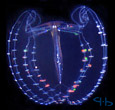| | C o m m o n M i s c o n c e p t i o n s | |||||||||||||||||||||||||||||||||
|
|
| |
There are some commonly held misconceptions about bioluminescence.
Myth: Bioluminescence is the same as "fluorescence" (or "phosphorescence",
or "chemiluminescence").
FACT: All of the terms apply to the production of light from chemicals,
but bioluminescence is only similar to chemiluminescence.
In fluorescence, the energy from an external source of light is absorbed and
almost immediately reëmitted. (See Chemistry for more detail.) The emitted light, with its modified color, is only visible while the stimulating light is turned on. You don't see fluorescence in complete darkness. Because energy must be conserved, the wavelength
that comes out is longer (=redder, =less energy) than what went
in. This is how laundry detergents can get things "whiter than
white": by absorbing non-visible UV light and fluorescing in the
visible spectrum.
Phosphorescence is similar to fluorescence except that the excited product is
more stable, so that the time until the energy is released is
much longer, resulting in a glow after the light has been removed.
This is the basis behind glow-in-the-dark stickers.
Chemiluminescence is a general term for production of light when the excitation
energy has come from a chemical reaction (as opposed to the absorption
of photons, in fluorescence).
Bioluminescence is a subset of chemiluminescence, where the light-producing chemical
reaction occurs inside an organism. Myth: All comb jellies luminesce and they make the colors of the rainbow
(or red). The main planktonic invertebrates (as distinct from protists) that don't luminesce are the heteropods and pteropods (although many other molluscs can make light). [Download printable PDF version of this page] |
|||||||||||||||||||||||||||||||
| | | | | ||||||||||||||||||||||||||||||||
|
| E-mail |
|||||||||||||||||||||||||||||||||
| | |

 .
.